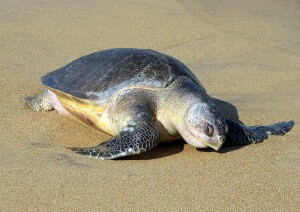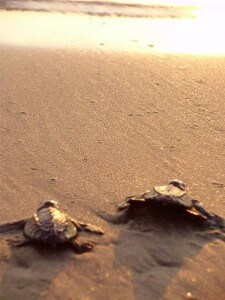As many of you know, WILD has a long history of involvement with the special Olive Ridley sea turtles. These turtles are currently known to nest en-mass in only three locations world-wide, one of which is Gaharimatha National Park, just south of the Dhamra River where the Dhamra Port Company Limited (DPCL) has begun to build a mega-port. The environmental and social issues and implications of this port are numerous and serious.
A new twist is unraveling in the Dhamra port project – the involvement of the International Union of the Conservation of Nature — not in opposing the port, but engaging with DPCL in a controversial manner.
This week, we were alerted of a letter sent to IUCN (following the official grievance policy) voicing unresolved and unaddressed concerns from stakeholders and specialists in India to IUCN staff. The letter expresses serious concerns regarding the nature of IUCN’s involvement in Orissa and is backed by leading specialists and IUCN members from India. Their main concerns are:
- Lack of scientific approach – no comprehensive environmental impact analysis has been completed for the port project.
- Concern that IUCN has not considered several critical environmental issues including invasive species carried in ballast water; impacts on Bhitarkanika National Park (Ramsar site, soon to be declared World Heritage site); impacts on Gahirmatha National Park, where the Olive Ridley’s nest; and others.
- Concern that IUCN has not considered critical social issues; no socio-economic or socio-cultural studies of communities at the construction site have been completed.
- Lack of holistic, integrated, comprehensive environmental and social approach. There is more going on in Dhamra than just the port expansion. Associated industries such as a ship-building yard, a steel plant and a port-based fertilizer plant are being planned at the same site. The cumulative environmental and social effects should be considered ‘with a wide-angle lense.’ “There has been no serious engagement by IUCN on the issue of unplanned coastal development and its consequences for marine biodiversity and marginalized coastal dwellers who depend directly on living marine resources and access to coastal areas.”
- IUCN is involved despite recommendations and concerns of local organizations including the Wildlife Protection Society of India, the Bombay Natural History Society, World Wildlife Fund-India and local members of the Marine Turtle Specialist Group (MTSG) of the IUCN.
- No genuine stakeholder meetings on the Dhamra project have been conducted by IUCN/MTSG. “Such lack of consultation squanders unique and considerable local expertise, besides sidelining local members.” The one meeting held by the IUCN was far from participatory, as many stakeholders, local organizations and IUCN members were not invited.
- IUCN has not followed its “Operational Guidelines for Private Sector Engagement”
Actions by the IUCN go against their guidelines, best practices and the mission: The IUCN Mission Statement “is to influence, encourage and assist societies throughout the world to conserve the integrity and diversity of nature and to ensure that any use of natural resources is equitable and ecologically sustainable.”
The many concerns close with a bold statement: “It appears that the IUCN-DPCL agreement is driven by corporate concerns rather than environmental ones which has lowered the credibility of the IUCN in India and around the world.”
Signers on the document then list multiple actions suggested for the IUCN with regard to the Orissa port project and encourage a meaningful response to their concerns. Signers include leading specialists in India and members of IUCN, such as Belinda Wright (Wildlife Protection Society of India), Ashish Fernandes (Greenpeace), Jack Frazier (Smithsonian Institution), Biswajit Mohanty (Wildlife Society of Orissa), Bittu Sahgal (Sanctuary Asia) and many others. Download the full document >



Totally unaware of the resistance between Tata Steel and Greenpeace regarding their existence, Olive Ridley turtles quietly return to their favorite place of Gahirmatha near Dhamra Port, for the annual nesting season 2010. Check this link: https://www.ioseaturtles.org/headline_detail.php?id=1758
Unlike last year, when only 167,000 turtles had come to nest at Gahirmatha, this year nearly 200,000 Olive Ridleys have laid eggs on the Gahirmatha beaches. In addition, more than 150,000 lakh Olive Ridleys have again arrived to lay eggs at the world’s largest rookery for sea turtles. This year’s figure of more than 350,000 congregations at Gahirmatha is highest in the decade. This video tells about the second mass nesting of the Olive Ridleys: https://www.youtube.com/watch?v=lFQxPW5uY3g.
The Olive Ridley Turtles are not affected by the Dhamra Port construction. They appeared at the Gahirmatha nesting beach for mass nesting, twice this year. Around 3.5 lakh Olive Ridley turtles successfully laid eggs during the annual nesting season 09-10. The nesting season spanned from February 24 to March 20. For more details: https://www.business-standard.com/india/news/turtle-nesting-at-gahirmatha-set-aside-green-concerndhamra/389846/
This is one brillliant article, and I hope to make use of it in a paper i would be writing regarding development and it’s bane more than the boons.
@Akansha: honestly,the turtles having tolerated the menace of the Port construction once doesn’t mean that they would do so every time. and we have no right to steal their natural habitat from them, and thereby make them extinct. we have lost our own peaceful lives thanks to our lifestyles these days, and are suffering endlessly for it…should we make the Turtles suffer to?